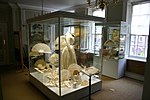Green Man, Blackheath
Buildings and structures demolished in 1970Demolished buildings and structures in LondonFormer pubs in LondonHarv and Sfn no-target errorsJazz clubs in London ... and 1 more
Pubs in the London Borough of Lewisham

The Green Man was a public house on Blackheath Hill (now the A2), in Blackheath, London. It was an important stop for coach traffic owing to its position and was used as the headquarters of the Royal Blackheath Golf Club. It hosted "free-and-easy" music hall evenings in the 19th century and jazz and pop music in the 20th. It was a significant local landmark for over 300 years before its demolition in 1970.
Excerpt from the Wikipedia article Green Man, Blackheath (License: CC BY-SA 3.0, Authors, Images).Green Man, Blackheath
Allison Close, London Deptford (London Borough of Lewisham)
Geographical coordinates (GPS) Address Nearby Places Show on map
Geographical coordinates (GPS)
| Latitude | Longitude |
|---|---|
| N 51.4725 ° | E -0.0081 ° |
Address
Allison Close 1-8
SE10 8AZ London, Deptford (London Borough of Lewisham)
England, United Kingdom
Open on Google Maps






